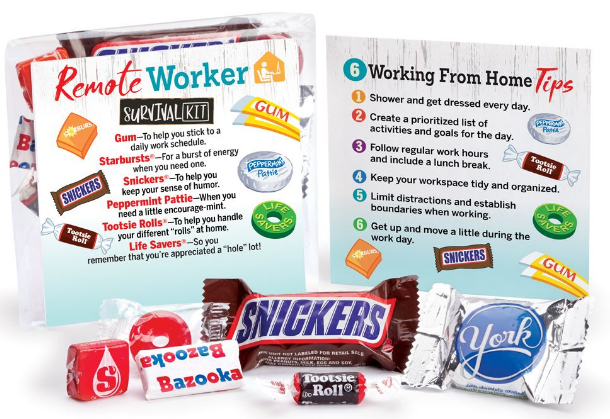BY ROBYN GOLDENBERG
COVID drastically changed how companies operate, and how the employees of those companies work, and more so, where they work. To cut costs a lot of companies nationwide made the switch from leasing large office spaces to reducing their square footage, or even closing physical offices entirely.
 For companies that are not reliant on delivering a physical product or service or needing to be physically in front of a customer, making the switch can be relatively simple. For other companies like manufacturing, transportation and logistics, and hospitality, switching to a completely remote workforce is probably not a workable solution. That doesn’t mean that these types of businesses should ignore the work-from-home benefits. Figuring out a hybrid solution could be the most economical way for some companies to maximize having both in-office and remote employees. Research is showing that some sort of remote work functionality is here to stay so it’s time to embrace the change and learn how to make remote work, work for you.
For companies that are not reliant on delivering a physical product or service or needing to be physically in front of a customer, making the switch can be relatively simple. For other companies like manufacturing, transportation and logistics, and hospitality, switching to a completely remote workforce is probably not a workable solution. That doesn’t mean that these types of businesses should ignore the work-from-home benefits. Figuring out a hybrid solution could be the most economical way for some companies to maximize having both in-office and remote employees. Research is showing that some sort of remote work functionality is here to stay so it’s time to embrace the change and learn how to make remote work, work for you.
Why remote work is here to stay.
- Having remote employees can reduce overall company costs. Even if you’re doing a hybrid model and still require some office presence, you may be able to find a smaller space if you’re leasing or by renting out some of your own space. The savings in rent alone might be enough to make it worth it; however, don’t forget that there are other associated costs that come with having a physical space. Go through your P&L and highlight what costs are directly related to having a physical office. Remember that you will still need to provide computer equipment to your remote employees—which you may already have—so costs associated with equipment and IT may not change.
- The talent pool is much wider geographically. This means that you can recruit from anywhere in the country (or internationally), which can be particularly helpful in competitive job markets. They also might be able to handle customer service/reservations, and even dispatch positions at different times. With coverage across different time zones, you may be able to maximize the efficiency of your business, and service more customers. This also means you will get more diversity—people from different cities and backgrounds leads to more ideas, and ultimately a competitive advantage.
- Improves employee retention. A study conducted by Miro found that 91 percent of those surveyed believe that remote works best for them, and that 96 percent would recommend working remotely to a friend (note that some other polls have lower numbers, often reporting in the 60 or 70 percentile, but the majority is overwhelmingly in support of remote work situations). Happy employees tend to stick around, and happy employees are the best kinds to have interacting with your customers.
- Saving commute time is good for employees and the environment. A study released from FlexJobs—which included case studies of Xerox, Dell, and Aetna—estimated an annual savings of $20 million in gas, 54 million in greenhouse gas emissions (from taking cars off the road every year), 640 million barrels of oil, and 119 billion miles of highway driving. Outside of the environmental perks, think about how much unproductive time is spent commuting to and from an office on a daily basis, and then multiply that by five days on average. How much could an employee get done if they didn’t have to be in the car for those hours every week? And how much money would they save on their vehicle-related expenses by not driving as much? It all adds up.
 Maintaining company culture is one of the biggest concerns we hear across the board from business owners when they’re looking at switching or adding remote employees. It was a concern that we had initially as well, but there are multitudes of technologies available to ensure communication across the organization.
Maintaining company culture is one of the biggest concerns we hear across the board from business owners when they’re looking at switching or adding remote employees. It was a concern that we had initially as well, but there are multitudes of technologies available to ensure communication across the organization.
- Team culture is made up of your company’s values, beliefs, attitudes, and behaviors shared by your employees. It’s about how your people work together towards common company goals.
- The company culture doesn’t go away because people are working remotely, as long as the goals and expectations are communicated and reinforced, and people are encouraged to work collaboratively versus alone in silos. Even companies with physical offices can lack company culture.
- Creating or enforcing company culture with remote teams does require some additional thought and actions, and it’s a vital step to complete. It’s important to think about how you may have traditionally kept up your company culture, and how that may translate to people who are not in your physical office.
- Giving your team a place to communicate and collaborate across remote and in-office employees is crucial to the success of this. There are plenty of software platforms to help manage company projects (e.g., Monday.com) and other platforms that allow for inter-employee communication (e.g., Microsoft Teams).
- Allowing time for employees to be social with each other—like they would be in an office, recognizing special events or occasions, or even sending out gift cards for coffee or lunch—is a great way to reinforce that the company cares about their team, regardless of their physical location.
- You want to make sure to keep open lines of communication with your team. Meet regularly as groups and on an individualized basis to check in and see if anyone is struggling, facing any challenges, or has any concerns about their work environment.
- Make sure that your employees have the technology and equipment they need to be successful in their jobs. One of our industry clients provides a computer, printer, VoIP phone, and even covers a desk and chair. All the things that you would normally provide to an in-office employee should apply to your remote employees. This also ensures that everyone is working at the same level.
- Probably the hardest part for hands-on business owners is knowing whether or not their employees are actually working. You can set up project tracking, and have regular meetings to check in on progress, but at the end of the day, you as an owner have to practice trusting your team. You hired them for a reason, so trust that they are being productive until they prove you wrong.
- As employees adjust to either moving to working from home, or settle in as brand-new remote employees, there will be a learning curve for the team (even you). That’s OK—don’t jump down people’s throats as they are adjusting. Learning and building new habits takes time, not to mention trial and error.
- One final tip: Focus on work output and not on process. Working from home is not the same experience as working in an office. The flow of your day as remote worker is vastly different than in the office. It’s important to enable employees to complete their tasks and projects in the most productive ways for them. There’s obviously a balance here between time-sensitive tasks and project work, but it’s key to recognize that the results sometimes outweigh the “how it got done.” So long as work and company standards are being upheld, and it isn’t impacting other team members’ workflow, the when and how becomes a little less important. This might also be a lesson you want to cross over into your in-office environment.
- Customer service reps and reservationists are probably the number one on this list to work remotely, especially if you have the right systems in place so they can do their jobs seamlessly. I might get flack for this, but dispatchers also make great work-from-home positions. We have a few clients who have dispatchers and res agents who work from home full time and are very successful at it.
- Other office positions that are easily adaptable to working remotely include any marketing functions like social media, website management, content creation, etc., as well as your finance department and payroll. It’s all about figuring out the essential functions of these positions and how to adapt them.
As you would with an in-office employee, managing work hours and boundaries is still important for remote workers. If you need time with them before they’re supposed to start or after hours, don’t assume that they can do it just because they’re at home. Boundaries are healthy.
Not only does the physical location change, but the way people work is changing as well. For certain positions that are not time sensitive, giving more flexibility could prove beneficial. As long as employees are getting their projects done on time and at or above standard, there’s little reason to micromanage when they complete tasks. Resist the urge to virtually hover over employees as much as possible. That is a sure-fire way to lose great employees.
You may need to update and upgrade your IT infrastructure. This could seem like a large upfront cost, but just as you might update your other systems, improving your IT infrastructure to match your growing and changing workforce can be an asset. Be sure to seek out a reputable IT company to talk to them about the best options for your operations. We have clients with multiple locations across the country, and they tend to operate on a cloud server so everyone is working from the same system, ensuring continuity. Other options like Google Drive and Microsoft Sharepoint also exist and might be best for your operation.
And finally: Don’t look at remote work as a perk or company benefit. It’s not about where you work, it’s about how you work. If you’re going to adapt remote work as part of your company culture and vision, it’s just that: a company standard, and an option for employees, not something to be used as a bargaining chip or perk. [CD0521]
Robyn Goldenberg is the Chief Marketing Officer and Director of Operations for Strategy Leaders. She can be reached at robyn@strategyleaders.com.

